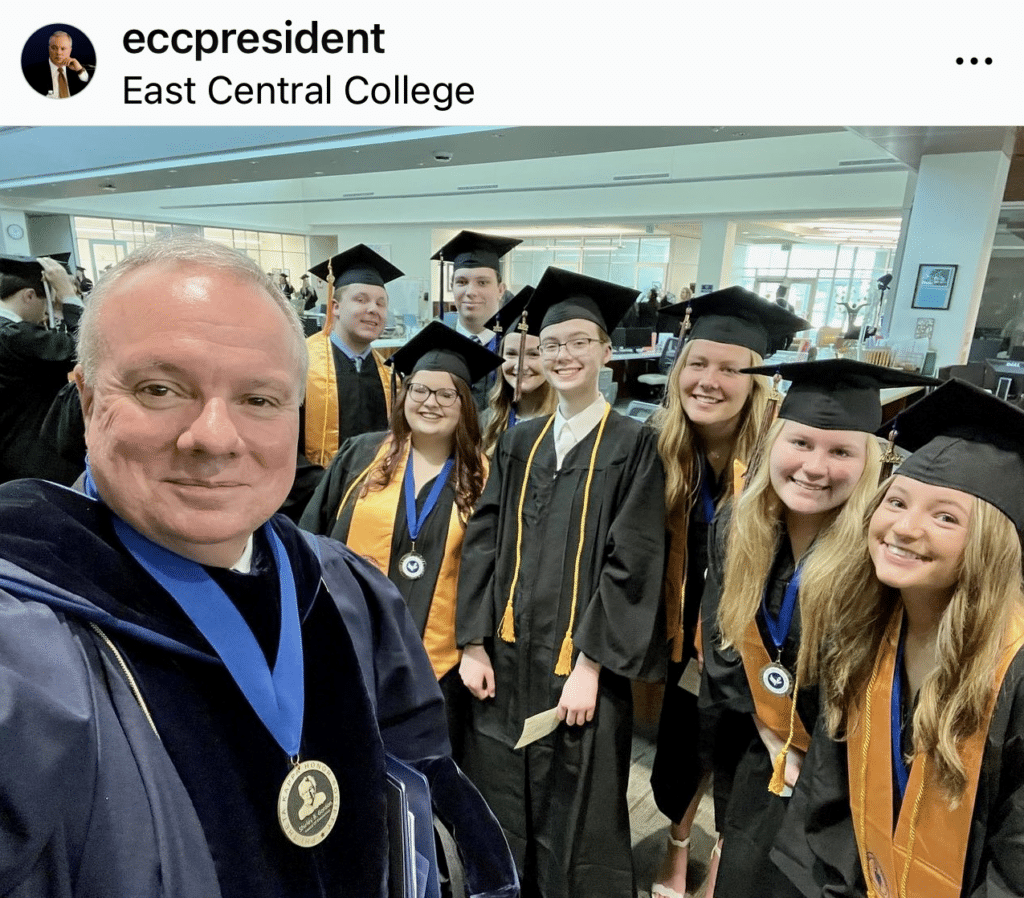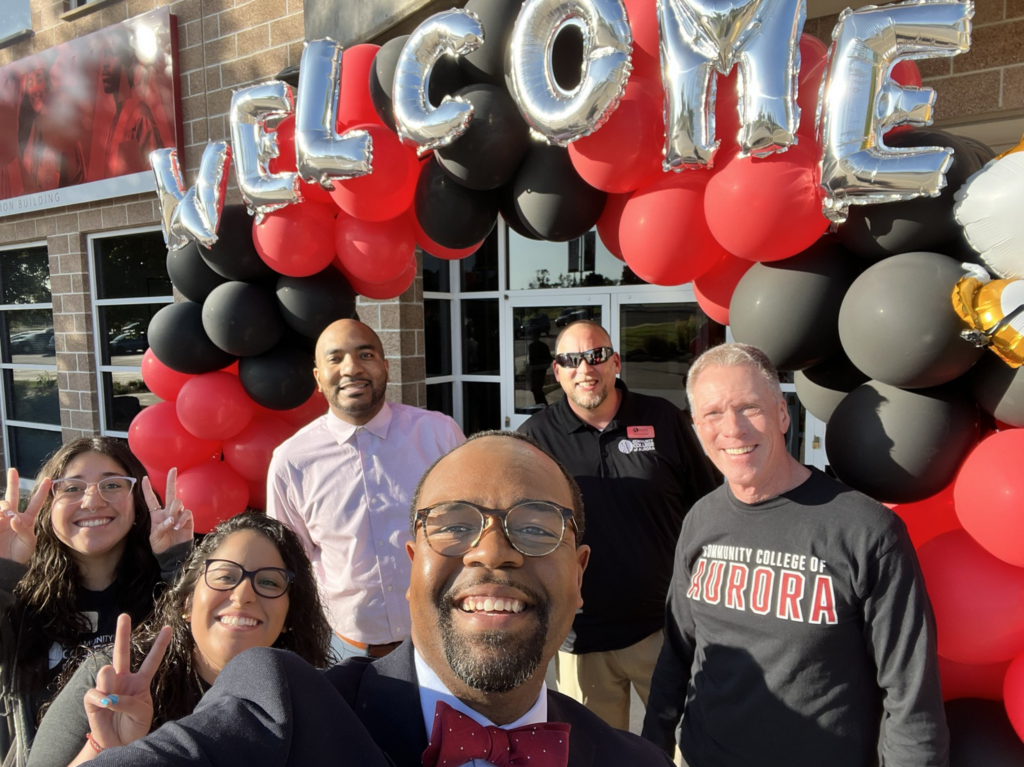With the power to inform, connect, engage and make presidents more visible, social media emerged as a vital instrument in educational leaders’ arsenals. Through insights garnered from discussions with 10 community college presidents effectively leveraging social platforms, it becomes evident that the impact of a president’s role in social media extends far beyond information sharing – it is a powerful force that can steer an institution toward success.

Central to effective leadership is the art of informed decision-making. Social media, in this context, acts as a source of diverse perspectives, emerging trends and relevant insights. It provides access to a wider range of information from various sources, which can be helpful in making decisions, says Jon Bauer, president of East Central College in Missouri. This curated, up-to-date knowledge empowers presidents to navigate dynamic challenges, leveraging collective intelligence to make well-rounded choices.
This article is part of a monthly series provided by the National Council for Marketing & Public Relations (NCMPR), an affiliated council of the American Association of Community Colleges.
John Rainone, president of Mountain Gateway Community College in Virginia, notes that social media has been a great professional development opportunity for him, allowing him to learn about what other institutions are doing and bring new ideas for programs, events, speakers and practices to his institution.
“It’s almost like a big digital conference that’s going on all the time,” says Steve Robinson, president of Lansing Community College in Michigan.
If higher education leaders were once able to connect with peers only at infrequent conferences or other meetings, social media gives them access to valuable resources, latest trends and news in higher education in real-time.
A catalyst for partnerships and progress
Social media serves as an invaluable platform for expanding a president’s network and cultivating meaningful connections with a diverse array of stakeholders, including legislators, business leaders and alumni. These connections, in turn, offer unprecedented access to a wealth of resources and opportunities.

For example, social media provides the ability to connect with policymakers at the state and federal levels. Thomas Huebner, president of Meridian Community College in Mississippi, says that thanks to social media, he has forged not just professional connections but genuine friendships.
While individual posts might not reach everyone, a steady stream of content effectively keeps crucial issues and events at the forefront of stakeholders’ attention, says Lane Glenn, president of Northern Essex Community College in Massachusetts. This sustained engagement plays a pivotal role in keeping the college community informed and engaged.

Resource mobilization is an inherent aspect of a president’s role; and social media serves as a conduit for advocacy, partnership building and fundraising. By showcasing collaborations and initiatives, presidents attract support that fuels growth and innovation. Mordecai Brownlee, president of the Community College of Aurora in Colorado, shares how strategic messaging attracted Amazon’s two-year sponsorship of the college’s first presidential scholarship program, paired with executive mentorship and community service.
Leigh Goodson, president of Tulsa Community College in Oklahoma, underscores the value of recognition and appreciation in nurturing partnerships. Goodson’s approach involves giving shout-outs on social media to partners and donors. This gesture not only reinforces partner and donor commitment to the college but also stimulates increased engagement and activity.
An engine of community engagement
At the core of every thriving community college is a deep understanding of the local economy’s demands and how the institution can support its community and individuals. Social media becomes the virtual bridge that allows presidents to directly engage with their constituents and gain valuable insights and feedback. The platforms help presidents shape the direction of their institutions.
Social media provides a unique window into people’s lives, revealing their interests beyond the professional realm. Robinson, for example, has a semimonthly Wednesday bike ride tradition at Lansing Community College. Known as Pedal with the Prez, the ride invites participants to cycle through town, concluding with a visit to an ice cream shop.
The evolution of Robinson’s bike ride tradition can be traced back to an Instagram connection with a colleague who shared his enthusiasm for cycling and suggested riding together. Through these genuine interactions and candid dialogues, college presidents foster a culture of transparency, accountability and trust, fortifying the bond between educational leaders and their communities.
A propeller of visibility and impact
The importance of being seen and valued resides at the core of community college success. Social media stands out as a dynamic platform to amplify triumphs, ventures and the institution’s pivotal role in shaping lives. Presidents’ heightened visibility sparks college recognition, elevates its reputation, attracts support and kindles employee engagement.
Rainone shared that increased visibility on social media has helped change community perceptions of Mountain Gateway Community College.
“The college is now part of the community,” he says, where before, it was sometimes described as an island whose drawbridge was never down.
Social media can also elevate faculty and student accomplishments, says Anne Kress, president of Northern Virginia Community College. She highlights the achievements of her faculty and student organizations through retweets and engagements, which supports their efforts and reinforces her commitment to the college.
In the rapidly evolving landscape of community colleges, the role of presidents has expanded beyond the confines of campus walls. Their active presence on social media is not just a preference but a strategic imperative. By fusing their vision with the power of social platforms, presidents can significantly enhance their influence and infuse their institutions with informed decisions, mutually beneficial connections, meaningful community engagement and an amplified impact.





